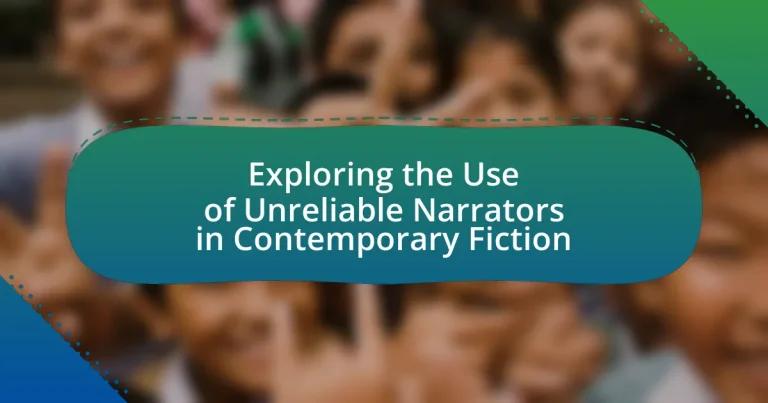Unreliable narrators in contemporary fiction are characters whose credibility is compromised, prompting readers to question the truth of their accounts. This article explores the definition, characteristics, and narrative techniques associated with unreliable narrators, highlighting their role in enhancing complexity and engaging readers in critical thinking. It examines notable examples from literature, such as “The Catcher in the Rye” and “Gone Girl,” and discusses the increasing prevalence of this narrative technique in modern storytelling, influenced by cultural factors and contemporary issues. Additionally, the article addresses the psychological effects on readers and best practices for writers in creating effective unreliable narrators.

What are Unreliable Narrators in Contemporary Fiction?
Unreliable narrators in contemporary fiction are characters whose credibility is compromised, leading readers to question the truth of their accounts. This narrative technique is employed to create ambiguity and provoke critical thinking, as seen in works like “The Catcher in the Rye” by J.D. Salinger, where the protagonist Holden Caulfield’s subjective perspective skews the portrayal of events. The use of unreliable narrators challenges readers to discern reality from deception, enhancing the complexity of the narrative and engaging them in deeper analysis of the text.
How do we define an unreliable narrator?
An unreliable narrator is a storyteller whose credibility is compromised, leading to a distorted or misleading account of events. This narrative technique is often employed to create suspense, challenge readers’ perceptions, or explore complex themes. For instance, in literature, characters like Holden Caulfield in “The Catcher in the Rye” exhibit traits of unreliability through their subjective interpretations and emotional biases, prompting readers to question the truth of their narratives.
What characteristics distinguish unreliable narrators from reliable ones?
Unreliable narrators are characterized by their lack of credibility, often due to personal biases, limited knowledge, or intentional deceit, while reliable narrators present information consistently and truthfully. Unreliable narrators may exhibit inconsistencies in their storytelling, provide subjective interpretations of events, or withhold critical information, which can lead readers to question their perspective. In contrast, reliable narrators typically maintain a coherent narrative, offer objective viewpoints, and provide sufficient context for the events described, allowing readers to trust their account. For example, in literature, a character who misinterprets events due to emotional turmoil serves as an unreliable narrator, while a character who recounts events with clarity and consistency exemplifies reliability.
Why do authors choose to use unreliable narrators?
Authors choose to use unreliable narrators to create complexity and engage readers in critical thinking about the narrative. This technique allows authors to challenge perceptions of truth and reality, prompting readers to question the reliability of the narrator’s perspective. For instance, in novels like “The Catcher in the Rye” by J.D. Salinger, the protagonist’s skewed viewpoint invites readers to interpret events differently, enhancing thematic depth and emotional resonance. This narrative strategy not only fosters suspense but also encourages deeper analysis of character motivations and societal norms, making the reading experience more interactive and thought-provoking.
What role do unreliable narrators play in storytelling?
Unreliable narrators play a crucial role in storytelling by challenging readers’ perceptions and creating ambiguity. This narrative technique engages the audience, prompting them to question the truthfulness of the narrator’s account and actively participate in piecing together the story. For instance, in novels like “The Catcher in the Rye” by J.D. Salinger, the protagonist’s subjective viewpoint leads to a distorted understanding of events, which reflects the complexities of human experience. This approach not only enhances thematic depth but also fosters a more immersive reading experience, as readers must navigate the layers of deception and bias presented by the narrator.
How do they influence reader perception and engagement?
Unreliable narrators significantly influence reader perception and engagement by creating ambiguity and prompting critical thinking. These narrators often present distorted or subjective viewpoints, which challenge readers to question the truth of the narrative. For instance, in novels like “Gone Girl” by Gillian Flynn, the dual perspectives of unreliable narrators lead readers to constantly reassess their understanding of the plot and characters, enhancing engagement through active participation in deciphering the story. This technique not only deepens emotional investment but also fosters a more immersive reading experience, as readers must navigate the complexities of truth and deception presented by the narrator.
What narrative techniques are commonly employed with unreliable narrators?
Unreliable narrators commonly employ techniques such as first-person perspective, selective detail, and contradictory statements. First-person perspective allows the narrator to present a subjective view, which can distort the truth. Selective detail involves the omission of critical information, leading readers to question the reliability of the narrator’s account. Contradictory statements create confusion and highlight the narrator’s flawed perception, prompting readers to critically analyze the narrative. These techniques effectively engage readers and challenge their understanding of the story, as seen in works like “The Catcher in the Rye” by J.D. Salinger, where Holden Caulfield’s perspective shapes the narrative’s ambiguity.

Why is the Use of Unreliable Narrators Increasing in Contemporary Fiction?
The use of unreliable narrators is increasing in contemporary fiction due to the desire for complex storytelling and deeper psychological exploration. Authors are leveraging unreliable narrators to challenge readers’ perceptions and create narratives that reflect the ambiguity of truth in modern society. This trend is supported by the rise of psychological thrillers and literary fiction that prioritize character depth and subjective experience, as seen in works like “Gone Girl” by Gillian Flynn and “The Girl on the Train” by Paula Hawkins, which both feature narrators whose credibility is intentionally compromised. This narrative technique engages readers by prompting them to question the reliability of the narrator and the nature of reality, making the reading experience more interactive and thought-provoking.
What cultural or societal factors contribute to this trend?
Cultural and societal factors contributing to the trend of using unreliable narrators in contemporary fiction include the rise of postmodernism and increasing skepticism towards authority. Postmodernism, which gained prominence in the late 20th century, emphasizes subjective experiences and challenges traditional narratives, leading authors to experiment with unreliable perspectives. Additionally, societal shifts towards questioning established truths, fueled by events such as political scandals and media misinformation, have made readers more receptive to narratives that reflect ambiguity and complexity. This context encourages writers to explore themes of perception and truth, as seen in works like “Gone Girl” by Gillian Flynn, where the unreliable narrator enhances the story’s tension and depth.
How do contemporary issues reflect in the narratives of unreliable narrators?
Contemporary issues are often reflected in the narratives of unreliable narrators by showcasing the complexities of truth and perception in a rapidly changing society. For instance, themes such as mental health, identity, and social justice are frequently explored through characters whose perspectives are skewed or deceptive, highlighting the subjective nature of reality. A notable example is the novel “The Catcher in the Rye” by J.D. Salinger, where the protagonist Holden Caulfield’s unreliable narration reveals his struggles with trauma and alienation, mirroring contemporary discussions about mental health awareness. This narrative technique allows readers to engage critically with the text, questioning the reliability of the narrator while also reflecting on broader societal issues.
What impact does digital media have on the portrayal of unreliable narrators?
Digital media significantly enhances the portrayal of unreliable narrators by providing diverse platforms for storytelling and audience interaction. Through blogs, social media, and interactive narratives, creators can present fragmented perspectives that challenge traditional linear storytelling. For instance, platforms like Twitter allow authors to share unreliable narratives in real-time, creating a sense of immediacy and engagement that deepens the reader’s experience of doubt and ambiguity. Additionally, digital media facilitates the use of multimedia elements, such as videos and audio clips, which can further distort or complicate the narrator’s reliability, as seen in projects like “The Night Vale Podcast,” where the unreliable narrator is central to the storytelling experience. This multifaceted approach not only broadens the scope of unreliable narration but also invites audiences to actively question and interpret the narrative, thereby enriching the overall impact of the unreliable narrator in contemporary fiction.
How do readers respond to unreliable narrators?
Readers often respond to unreliable narrators with a mix of intrigue and skepticism. This engagement arises from the challenge of deciphering the truth behind the narrator’s perspective, prompting readers to actively question the narrative and analyze the motives and reliability of the character. Research indicates that unreliable narrators can enhance reader engagement by creating a sense of mystery and encouraging critical thinking, as seen in works like “The Catcher in the Rye” by J.D. Salinger, where the protagonist’s skewed perception invites readers to interpret events differently. This dynamic interaction fosters a deeper connection to the text, as readers navigate the complexities of truth and deception presented by the narrator.
What psychological effects do unreliable narrators have on the audience?
Unreliable narrators create psychological effects on the audience by inducing feelings of confusion, mistrust, and engagement. These narrators often present distorted perceptions of reality, which can lead the audience to question the truthfulness of the narrative. Research indicates that this cognitive dissonance can enhance emotional investment, as viewers or readers actively piece together the truth from misleading information. For example, studies show that narratives featuring unreliable narrators can stimulate critical thinking and deeper analysis, as audiences must navigate the complexities of the story and discern the narrator’s motives. This interaction fosters a more immersive experience, compelling the audience to engage with the text on a psychological level.
How does reader interpretation change with unreliable narratives?
Reader interpretation shifts significantly with unreliable narratives, as these narratives compel readers to question the truthfulness of the information presented. When a narrator is deemed unreliable, readers become more active participants in the storytelling process, analyzing inconsistencies and seeking deeper meanings behind the text. This engagement often leads to multiple interpretations, as readers may construct their own understanding based on clues and subtext rather than accepting the narrator’s account at face value. Research indicates that unreliable narrators can enhance thematic complexity and provoke critical thinking, as seen in works like “The Catcher in the Rye” by J.D. Salinger, where the protagonist’s subjective viewpoint challenges readers to discern reality from perception.

What are Some Notable Examples of Unreliable Narrators in Contemporary Fiction?
Notable examples of unreliable narrators in contemporary fiction include Patrick Bateman in “American Psycho” by Bret Easton Ellis, who presents a distorted view of reality through his psychopathic lens, and the protagonist in “The Catcher in the Rye” by J.D. Salinger, Holden Caulfield, whose subjective experiences and emotional instability lead to a skewed perception of events. Additionally, in “Gone Girl” by Gillian Flynn, both Nick and Amy Dunne manipulate the narrative, creating a complex interplay of truth and deception. These characters exemplify how unreliable narration can enhance themes of perception, identity, and truth in literature.
Which contemporary novels feature prominent unreliable narrators?
Contemporary novels featuring prominent unreliable narrators include “The Girl on the Train” by Paula Hawkins, “Gone Girl” by Gillian Flynn, and “Life After Life” by Kate Atkinson. In “The Girl on the Train,” the protagonist’s alcoholism distorts her perception of reality, leading to misleading conclusions. “Gone Girl” employs dual perspectives, where both narrators manipulate the truth, creating a complex narrative. “Life After Life” explores multiple lives of the same character, challenging the reliability of memory and experience. These novels exemplify the use of unreliable narrators to enhance suspense and complexity in storytelling.
What techniques do these authors use to create an unreliable narrative?
Authors create an unreliable narrative through techniques such as selective narration, contradictory statements, and the use of flawed characters. Selective narration involves presenting only certain events or perspectives, which skews the reader’s understanding of the truth. For example, in “The Catcher in the Rye,” Holden Caulfield’s subjective viewpoint limits the reader’s access to objective reality. Contradictory statements, where the narrator’s claims conflict with established facts, further enhance the unreliability; in “Gone Girl,” Amy Dunne’s diary entries mislead readers about her true intentions. Flawed characters, who may be mentally unstable or biased, contribute to the narrative’s unreliability, as seen in “Fight Club,” where the protagonist’s dissociative identity disorder distorts his perception of reality. These techniques effectively engage readers in questioning the authenticity of the narrative.
How do these examples illustrate the effectiveness of unreliable narrators?
Unreliable narrators effectively engage readers by creating ambiguity and challenging perceptions of truth. For instance, in novels like “The Catcher in the Rye” by J.D. Salinger, the protagonist Holden Caulfield presents a skewed perspective that forces readers to question his reliability and motives, enhancing the narrative’s depth. Similarly, in “Gone Girl” by Gillian Flynn, alternating viewpoints reveal conflicting accounts that keep readers guessing about the characters’ true intentions, thereby heightening suspense. These examples demonstrate that unreliable narrators can manipulate narrative structure and reader expectations, leading to a more immersive and thought-provoking experience.
What themes are commonly explored through unreliable narrators?
Unreliable narrators commonly explore themes of perception versus reality, truth and deception, and the subjective nature of experience. These themes highlight how personal biases and limited perspectives can distort the understanding of events and characters. For instance, in “The Catcher in the Rye” by J.D. Salinger, the protagonist Holden Caulfield’s skewed viewpoint illustrates the theme of alienation and the struggle to find authenticity in a perceived phony world. Similarly, in “Gone Girl” by Gillian Flynn, the dual narratives reveal the complexities of marriage and manipulation, emphasizing how different interpretations of the same events can lead to vastly different conclusions.
How do unreliable narrators challenge traditional narrative structures?
Unreliable narrators challenge traditional narrative structures by subverting reader expectations and altering the perception of truth within the story. These narrators often provide biased or distorted accounts of events, leading readers to question the authenticity of the narrative. For instance, in works like “The Catcher in the Rye” by J.D. Salinger, the protagonist’s subjective viewpoint creates ambiguity, forcing readers to navigate between reality and the narrator’s flawed perspective. This technique disrupts linear storytelling and encourages active engagement, as readers must piece together the truth from conflicting information presented by the narrator.
What moral or ethical questions arise from their perspectives?
The use of unreliable narrators in contemporary fiction raises significant moral and ethical questions regarding truth, trust, and the manipulation of reader perception. These narrators often distort reality, leading to questions about the ethical implications of deceiving the audience and the responsibility of authors to present a narrative that respects the reader’s intelligence. Additionally, the portrayal of unreliable narrators can challenge societal norms and ethical boundaries, prompting discussions about the morality of representing trauma, mental illness, or criminal behavior through a skewed lens. Such narratives can influence readers’ understanding of complex issues, raising concerns about the potential for misinterpretation and the ethical obligation of writers to provide clarity amidst ambiguity.
What are the best practices for writing an unreliable narrator?
The best practices for writing an unreliable narrator include establishing a clear motive for the narrator’s unreliability, using selective detail to create ambiguity, and maintaining consistency in the narrator’s voice. Establishing a motive, such as personal bias or psychological instability, helps readers understand why the narrator may distort the truth. Selective detail allows the author to present information that can be interpreted in multiple ways, creating doubt about the narrator’s credibility. Consistency in the narrator’s voice ensures that readers remain engaged while questioning the reliability of the information presented. These techniques are effective in enhancing the complexity of the narrative and deepening reader engagement.
How can authors effectively build suspense and intrigue with unreliable narrators?
Authors can effectively build suspense and intrigue with unreliable narrators by strategically manipulating the narrator’s perspective and revealing information selectively. This technique creates a sense of uncertainty and encourages readers to question the truth of the narrative. For instance, when a narrator withholds critical details or presents events in a biased manner, it generates tension as readers attempt to discern reality from deception. A notable example is in “Gone Girl” by Gillian Flynn, where the dual perspectives of the unreliable narrators keep readers guessing about the true nature of the characters and their motivations. This method not only engages readers but also deepens the psychological complexity of the story, enhancing the overall suspense.
What common pitfalls should writers avoid when creating unreliable narrators?
Writers should avoid making their unreliable narrators too obvious or clichéd, as this can diminish the impact of the narrative twist. When the unreliability is immediately apparent, it can lead to a lack of engagement from the reader, who may feel less invested in uncovering the truth. Additionally, writers should refrain from inconsistent characterization, where the narrator’s voice or behavior fluctuates without justification, as this can confuse readers and undermine the story’s credibility. Maintaining a balance between subtlety and clarity is crucial; if the narrator’s unreliability is too subtle, readers may miss it entirely, while being too overt can spoil the narrative tension.




